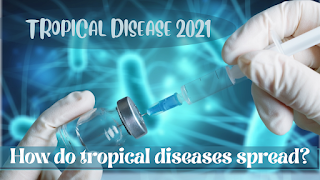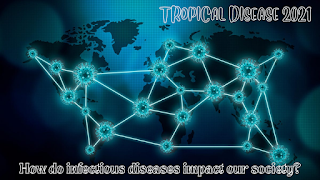How do tropical diseases spread?
Tropical
disease any disease that is native to or occurs primarily in tropical or
subtropical areas of the world is referred to as a tropical disease. Malaria,
cholera, Chagas disease, yellow fever and dengue fever are examples of
tropical diseases. Tropical diseases thrive in the tropics hot and humid
climate. Viruses, bacteria and parasites cause them and they spread
by airborne transmission, sexual contact and contaminated food and water
sources.
Tropical diseases thrive in the tropics hot and humid
climate. Viruses, bacteria and parasites cause them and they spread
by airborne transmission, sexual contact and contaminated food and water
sources. Through bug bites, insects or other animals can spread tropical
illnesses. Dengue
fever, yellow fever, rotavirus, AIDS, Ebola and Lassa fever are
examples of viral tropical infections. Cholera, E. coli, TB and Hansen's
disease are examples of bacterial tropical illnesses (leprosy). Tropical
infections can also be spread by parasitic single-celled protozoa and worms.
While feeding, mosquitoes can transmit a Plasmodia protozoon to humans. Malaria
is a disease in which protozoa attack the red blood cells of the host,
infecting 300 million people each year and killing one to three million.
Trypanosomiasis and leishmaniasis are two more parasitic illnesses produced by
protozoa. Microscopic worms infect the human body and cause schistosomiasis and
filariasis.
Some
germs are beneficial and even assist us in maintaining our health, while others
are toxic and cause infection. You can take effective action to prevent the
spread of infectious
diseases by understanding how individuals catch them. Germs enter the body
through the mouth, which includes eating, drinking and breathing; the skin,
which includes cuts and grazes; the eyes; and the genitals. Germs can spread
from person to person in several ways: directly from an infected person to an
object (such as door handles, bench tops or food) and then to another person
who comes into contact with the contaminated item; indirectly from a
contaminated environmental source, such as an animal or the soil, to a
susceptible person and from a contaminated environmental source, such as an
animal or the soil, to a susceptible person. Some infectious diseases are more
contagious than others, and not all infectious diseases spread in the same way.



I am from USA. I was suffering from HEPATITIS B for over 3 years, i was hopeless until one of my friend directed me to a herbal DR. Dr Chike on youtube, she said the Dr has herbal medicine that treat HEPATITIS B also said the Dr has helped people with. HERPES, CANCER, DIABETES, HPV, HERPES, HSV 1 .2, Fever, Fibromyalgia, Fatigue and chronic pains. I never believed her but after a lot of talk. I decided to contact him, just few days ago i contacted him and he told me what to do which i did and he sent to me a herbal medicine via {DHL} with prescriptions on how i will take it for a period of days. After i finished taking the medicine for 2 weeks he told me to go for a test which i also did and when the result came out i was surprised to see that i am negative. I am proud to tell you that I am the happiest person on earth. Big thanks to Dr Chike herbs .. I pray you find a solution in him. For more information on how to get treated Contact Dr on, text/call via: +1 (719) 629 0982 WhatsApp . +233502715551, or Facebook page, @ Dr Chike Herbal Remedy.
ReplyDelete